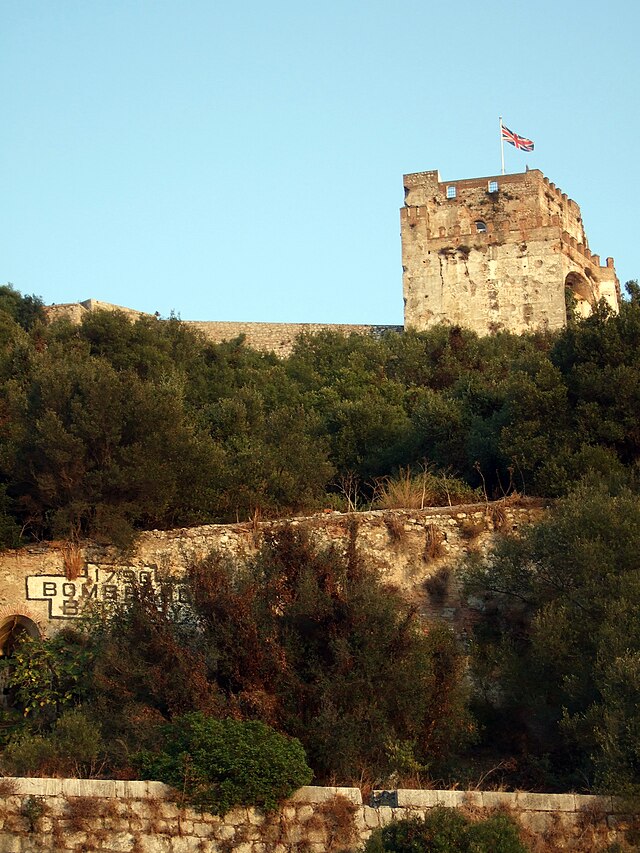Loading AI tools
Umayyad commander in Hispania (died c. 720) From Wikipedia, the free encyclopedia
Tariq ibn Ziyad (Arabic: طارق بن زياد Ṭāriq ibn Ziyād; c. 670 – c. 720), also known simply as Tarik in English, was an Umayyad commander who initiated the Muslim conquest of the Iberian Peninsula (present-day Spain and Portugal) against the Visigothic Kingdom in 711–718 AD. He led an army and crossed the Strait of Gibraltar from the North African coast, consolidating his troops at what is today known as the Rock of Gibraltar. The name "Gibraltar" is the Spanish derivation of the Arabic name Jabal Ṭāriq (جبل طارق), meaning 'mountain of Tariq', which is named after him.
Ṭāriq ibn Ziyād طارق بن زياد | |
|---|---|
 A depiction of Ṭāriq ibn Ziyād (right) and the last Visigothic king, Roderic (left) in the 15th century manuscript Semblanzas de reyes | |
| Born | c. 670 North Africa |
| Died | c. 720 Damascus, Syria |
| Allegiance | Umayyad Caliphate |
| Battles / wars | Conquest of Hispania |
| Other work |
|
Medieval Arabic historians give contradictory data about Ṭāriq's origins and ethnicity. Some conclusions about his personality and the circumstances of his entry into al-Andalus are surrounded by uncertainty.[1] The vast majority of modern sources state that Ṭāriq was a Berber mawla of Musa ibn Nusayr, the Umayyad governor of Ifriqiya.[1][2][3][4]
According to Ibn Khaldun, Tariq Ibn Ziyad was from a Berber tribe in what is now Algeria.[5] Heinrich Barth mentions that Tariq Ibn Ziyad was a Berber from the tribe of the Ulhassa,[6] a tribe native to the Tafna[7] that currently inhabits the Béni Saf region in Algeria.[8] According to David Nicolle, Tariq Ibn Ziyad is first mentioned in historical records as the governor of Tangier.[5] Additionally, as per David Nicolle, it is traditionally believed that he was born in Wadi Tafna (a region in present day Tlemcen).[5][9] He had also lived there with his wife prior to his governance of Tangier.[10]

According to Ibn Abd al-Hakam (803–871), Musa ibn Nusayr appointed Ṭāriq governor of Tangier after its conquest in 710–711,[11] but an unconquered Visigothic outpost remained nearby at Ceuta, a stronghold commanded by a nobleman named Julian, Count of Ceuta.
After Roderic came to power in Spain, Julian had, as was the custom, sent his daughter, Florinda la Cava, to the court of the Visigothic king for education. It is said that Roderic raped her, and that Julian was so incensed he resolved to have the Muslims bring down the Visigothic Kingdom. Accordingly, he entered into a treaty with Ṭāriq (Mūsā having returned to Qayrawan) to secretly convoy the Muslim army across the Straits of Gibraltar, as he owned a number of merchant ships and had his own forts on the Spanish mainland.[12]
On or about April 26, 711, the army of Ṭāriq Bin Ziyad, composed of recent Berber converts to Islam, was landed on the Iberian peninsula (in what is now Spain) by Julian.[lower-alpha 1] They debarked at the foothills of a mountain which was henceforth named after him, Gibraltar (Jabal Tariq).[13]
Ṭāriq's army contained about 7,000 soldiers, composed largely of Berber stock but also Arab troops.[14] Roderic, to meet the threat of the Umayyads, assembled an army said to number 100,000,[15] though the real number may well have been much lower.[16] Most of the army was commanded by, and loyal to, the sons of Wittiza, whom Roderic had brutally deposed.[17] Ṭāriq won a decisive victory when Roderic was defeated and killed on July 19 at the Battle of Guadalete.[1][18]
Ṭāriq Bin Ziyad split his army into four divisions, which went on to capture Córdoba under Mughith al-Rumi, Granada, and other places, while he remained at the head of the division which captured Toledo. Afterwards, he continued advancing towards the north, reaching Guadalajara and Astorga.[1] Ṭāriq was de facto governor of Hispania until the arrival of Mūsā a year later. Ṭāriq's success led Musa to assemble 12,000 (mostly Arab) troops to plan a second invasion. Within a few years, Ṭāriq and Musa had captured two-thirds of the Iberian peninsula from the Visigoths.[19][20]
Both Ṭāriq and Musa were simultaneously ordered back to Damascus by the Umayyad Caliph Al-Walid I in 714, where they spent the rest of their lives.[18] The son of Musa, Abd al-Aziz, who took command of the troops of al-Andalus, was assassinated in 716.[2] In the many Arabic histories written about the conquest of southern Spain, there is a definite division of opinion regarding the relationship between Ṭāriq and Musa bin Nusayr. Some relate episodes of anger and envy on the part of Mūsā that his freedman had conquered an entire country. Others do not mention, or play down, any such bad blood. On the other hand, another early historian, al-Baladhuri, writing in the 9th century, merely states that Mūsā wrote Ṭāriq a "severe letter" and that the two were later reconciled.[21]
The 16th-century historian Ahmed Mohammed al-Maqqari, in his The Breath of Perfume, attributes a long speech by Ṭāriq to his troops before the Battle of Guadalete.[22][23][24]
Seamless Wikipedia browsing. On steroids.
Every time you click a link to Wikipedia, Wiktionary or Wikiquote in your browser's search results, it will show the modern Wikiwand interface.
Wikiwand extension is a five stars, simple, with minimum permission required to keep your browsing private, safe and transparent.